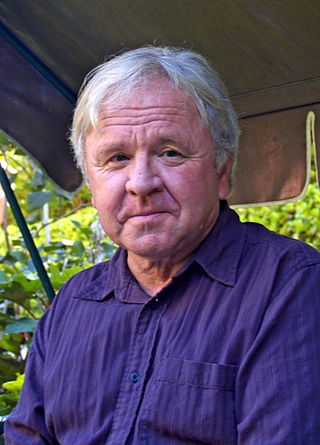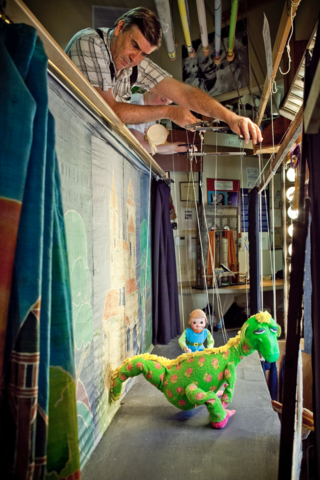
Puppetry is a form of theatre or performance that involves the manipulation of puppets – inanimate objects, often resembling some type of human or animal figure, that are animated or manipulated by a human called a puppeteer. Such a performance is also known as a puppet production. The script for a puppet production is called a puppet play. Puppeteers use movements from hands and arms to control devices such as rods or strings to move the body, head, limbs, and in some cases the mouth and eyes of the puppet. The puppeteer sometimes speaks in the voice of the character of the puppet, while at other times they perform to a recorded soundtrack.

Lili is a 1953 American film released by MGM. It stars Leslie Caron as a touchingly naïve French girl whose emotional relationship with a carnival puppeteer is conducted through the medium of four puppets. The film won the Academy Award for Best Original Score, and was also entered in the 1953 Cannes Film Festival. It was later adapted for the stage under the title Carnival! (1961).

Children's Fairyland, U.S.A. is an amusement park, located in Oakland, California, on the shores of Lake Merritt. It was one of the earliest "themed" amusement parks in the United States. Fairyland includes 10 acres (4.0 ha) of play sets, small rides, and animals. The park is also home to the Open Storybook Puppet Theater, the oldest continuously operating puppet theater in the United States.

David Talbot is an American journalist, author, editor, activist and independent historian. Talbot is known for his books about the "hidden history" of U.S. power and the liberal movements to change America, as well as his public advocacy. He was also the founder and former editor-in-chief of the early web magazine Salon.

The Duplicate, published in 1988, is a science fiction novel for young adults written by William Sleator. The novel explores themes of identity.

KPYX, branded as KPIX+, is an independent television station licensed to San Francisco, California, United States, serving the San Francisco Bay Area. It is owned by the CBS News and Stations group alongside KPIX-TV, the market's CBS owned-and-operated station. The two stations share studios at Broadway and Battery Street, just north of San Francisco's Financial District; KPYX's transmitter is located atop Sutro Tower.

John Picacio is an American artist specializing in science fiction, fantasy and horror illustration.
The San Francisco Board of Education is the school board for the City and County of San Francisco. It is composed of seven Commissioners, elected by voters across the city to serve 4-year terms. It is subject to local, state, and federal laws, and determines policy for all the K-12 public schools in the San Francisco Unified School District.

Basil Twist is a New York City-based puppeteer who is known for his underwater puppet show, "Symphonie Fantastique". He was named a MacArthur Fellowship recipient on September 29, 2015.

A puppet is an object, often resembling a human, animal or mythical figure, that is animated or manipulated by a person called a puppeteer. Puppetry is an ancient form of theatre which dates back to the 5th century BC in ancient Greece.

Kerry Waghorn is a syndicated caricaturist whose Faces in the News feature, established in 1977 by Chronicle Features is a journalistic legend. He estimates that more than 9,000 of his images have been published since the early 1970s, including just about every prominent news, business and entertainment face over that span of history. During the many years he spent under the management of newspaper icon G. Stanleigh Arnold, the Chronicle's Sunday and Features Editor, he refined his skills within a team that included Garry Trudeau (Doonesbury), Gary Larson, Abigail Van Buren, William Hamilton, Phil Frank (Farley), and Cathy Guisewite (Cathy). Arnold had also been instrumental in the early stages of Charles Schulz' (Peanuts) career. Waghorn, who resides in West Vancouver, B.C., is currently represented by Universal Press Syndicate of Kansas City, MO, and he continues to create about three new caricatures a week. Universal, a subsidiary of Jim Andrews and John McMeel's Andrews McMeel Universal, founded in 1970, purchased Chronicle Features in 1997.

Puppeteer (パペッティア) is a platform video game developed by Japan Studio for the PlayStation 3. It was directed by Gavin Moore. The game was released worldwide in September 2013.
Robert Boardman Howard (1896–1983), was a prominent American artist active in Northern California in the first half of the twentieth century. He is also known as Robert Howard, Robert B. Howard and Bob Howard. Howard was celebrated for his graphic art, watercolors, oils, and murals, as well as his Art Deco bas-reliefs and his Modernist sculptures and mobiles.
Marion Derby was an author, artist, and zen student of Shunryū Suzuki.

Randal John Metz is a professional puppeteer and variety/stage performer. He is known for creating puppet productions, and puppet performer for Children’s Fairyland’s Open Storybook Puppet Theater in Oakland, California, the oldest continuously operating puppet theater in the United States. He currently produces seven different puppet shows a year for the theater, and tours his shows throughout California under the name The Puppet Company. He has served several terms as President and Vice-President of the San Francisco Bay Area Puppeteers Guild.

Charles Caldwell Dobie was a writer and historian in San Francisco. His novel The Blood Red Dawn was adapted into the movie The Inner Chamber in 1921. His stories were published in magazines and included in anthologies. He also received honors for his work. He wrote several novels. His work featured his hometown, San Francisco. The Bancroft Library at the University of California at Berkeley has a collection of his papers.

Antonio "Tony" Sotomayor (1902–1985) was a Bolivian-born American artist and educator, known as a painter and muralist. He also worked as an illustrator, caricaturist, designer, and ceramicist. He was nicknamed San Francisco's 'Artist Laureate'.

In 1941, Anton Refregier won the $26,000 commission for the series History of San Francisco, which are a set of 27 murals painted in the lobby of the Rincon Annex Post Office in San Francisco, California. Refregier painted the mural with casein tempera on white gesso over plaster walls, in the social realism style. Work was interrupted by World War II and restarted in 1946; the murals were completed in 1948.
The Luggage Store Gallery, also known as 509 Cultural Center, is a non-profit, multi-disciplinary arts organization founded in 1987, and has two venues located in the Tenderloin neighborhood of San Francisco, California. The organization has sponsored many local artists, including those that are considered to be part of the Mission School, and of skateboard or street art culture.

A Quest of Heroes is a 2013 young adult fantasy fiction book by Morgan Rice.
















